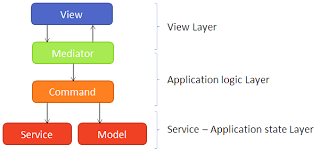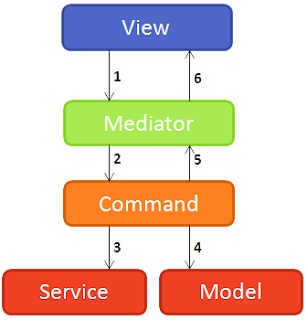http://jedicoder.blogspot.be/2013/03/javafx-structuring-your-application.html
——————————————————————————————————————————————————————————————————————
Introduction
JavaFx is a new rich client framework by Oracle. It allows you to create visually pleasing enterprise business applications with the Java language.
While many small demos are showing up in the community, there aren't
many articles on how to structure your JavaFx application. Using a good
structure makes it easier to maintain your application, add new features
and improves overall stability. These are all very important in
enterprise applications.
This serie of articles will try to remedy that by showing you one of
many ways to structure your application. This is certainly not the only
way to do it, but it will give you a starting point. Even this structure
is open for improvement (as every structure is).
This serie will consist of four blog posts:
- Overview (this blog post)
- View layer
- Application logic layer
- Service - Application State layer
High-level Overview
The structure I will describe is based on Robotlegs, an Apache Flex
micro-architecture library. But instead of using events to decouple the
layers, I went with for direct calls (with interfaces in-between). While
events allow you to decouple the layers even more, I prefer direct
calls with interfaces over events because they make it easier to follow
the flow of your application.
The diagram below shows the different components and layers in my architecture. The arrows indicate the dependencies.

- View: This is where the JavaFx components are used to build the UI.
- Mediator: The mediator facilitates the communication between the view and the application logic layer. This is why it's both included in the view layer as the application logic layer. This layer should not contain application logic, it's just a postman who receives calls from the view and delegates them to the application logic layer and vise versa.
- Command: This is where your application logic will reside. A Command is a class which executes a single unit of work and will be disposed when it's finished.
- Service: A service is used to access external resources. This can be a remote service, a file on the filesystem or a device attached to the user's pc.
- Model: A model stores the state of your application. This can be the selected record which should be accessible in multiple views.
The diagram below shows a sample flow of an application. In this case
the user clicked on a button to delete a contact in a list.

- The view asks the mediator to delete the item by calling the deleteContact(contact) method on the IContactListMediator interface.
- The mediator creates a new DeleteContactCommand and registers a success handler on it. Then it calls the start() method on the command.
- The command calls the contact service to delete the contact from the database
- The command calls a method on the model to remove the contact from the application state. It receives the updated list of contacts from the model
- The command finishes and triggers the registered success listeners. It provides the updated list of contacts to the success handlers.
- The success handler in the mediator asks the view to update the list of contacts based on the updated contact list it got from the command.
Used libraries
For my application I didn't use any framework (except for JavaFx,
obviously), I wanted to create my own structure without the overhead of a
framework. All I used was the JavaFx framework and Guice for dependency
injection.
For those interested in build tools, I used the JavaFx Gradle plugin created by Danno Ferrin to create a build script.
Dependency Injection
Mapping your dependencies
A DI library like Guice allows you to inject instances of certain
classes into other classes without you having to manually instantiate
and inject them. This can greatly improve the quality of your code since
you don't have to write all that yourself. Guice is basically the glue
that holds your application together.
In Guice you have to create a Module class which defines all the
mappings. Such a module class can look like this for a simple
application:
public class EventManagerModule extends AbstractModule { @Override protected void configure() { bind(EventManagerModule.class).toInstance(this); mapViews(); mapMediators(); mapCommands(); mapServices(); mapModels(); mapInfrastructure(); } private void mapViews() { bind(IEventOverviewView.class).to(EventOverviewView.class); bind(IEventListView.class).to(EventListView.class); bind(IEventDetailView.class).to(EventDetailView.class); } private void mapMediators() { bind(IEventOverviewMediator.class).to(EventOverviewMediator.class); bind(IEventListMediator.class).to(EventListMediator.class); bind(IEventDetailMediator.class).to(EventDetailMediator.class); } private void mapCommands() { bind(CommandProvider.class); bind(LoadEventsCommand.class); bind(AcceptEventCommand.class); bind(DeclineEventCommand.class); } private void mapServices() { bind(IEventService.class).to(StubEventService.class); } private void mapModels() { bind(IEventSelectionModel.class).to(EventSelectionModel.class).in(Singleton.class); } private void mapInfrastructure() { bind(ITranslationProvider.class).to(ResourceBundleTranslationProvider.class).in(Singleton.class); } }
So in most cases you will be mapping implementations to interfaces. Always try to use interfaces. This allows you to, for example, create a stub implementation of a service (in this case StubEventService) and a real implementation which you can then just swap by changing the Guice mapping.
Only for the Commands I didn't create interfaces because they wouldn't
add that much value. They would all practically be marker services, but
you'll see that in my following posts.
While this Module implementation is ok for a small application, it can
quickly explode in one huge class when you're building a bigger
application. This is where bootstrap classes come in handy. A bootstrap
class is just a class which initializes a certain part of your
application. In this case it would initialize the mappings of the views,
the mediators or the commands. Such a bootstrap class would look like
this:
public class MediatorMapper implements Mapper { private AbstractModule module; public MediatorMapper(AbstractModule module) { this.module = module; } public void bootstrap() { module.bind(IEventOverviewMediator.class).to(EventOverviewMediator.class); module.bind(IEventListMediator.class).to(EventListMediator.class); module.bind(IEventDetailMediator.class).to(EventDetailMediator.class); } }
Your module would then look like this:
public class EventManagerModule extends AbstractModule { @Override protected void configure() { bind(EventManagerModule.class).toInstance(this) new ViewMapper(this).bootstrap(); new MediatorMapper(this).bootstrap(); new CommandMapper(this).bootstrap(); new ServiceMapper(this).bootstrap(); new ModelMapper(this).bootstrap(); new ModelMapper(this).bootstrap(); } }
Wiring it all together
Now how do you wire all this together? Well, that is what I'm going to show you now.
In your Main class you will create a Guice Injector and with this
injector you will instantiate the main view of your application.
Your Main class will look like this:
public class Main extends Application { public static void main(String[] args) { Application.launch(); } @Override public void start(Stage stage) throws Exception { Injector injector = Guice.createInjector(new EventManagerModule()); EventOverviewView eventOverviewView = injector.getInstance(EventOverviewView.class); Scene scene = SceneBuilder.create() .root( eventOverviewView.getView() ).width(900) .height(700) .build(); scene.getStylesheets().add(Main.class.getResource("/EventManager.css").toExternalForm()); stage.setScene(scene); stage.show(); } }
The views that are being used in the main view are also injected in the main view. Also, the mediator that is behind the main view is also injected. This patterns is used for every view.
public class EventOverviewView implements IEventOverviewView { @Inject public IEventOverviewMediator mediator; @Inject public EventListView eventListView; @Inject public EventDetailView eventDetailView; ... }
Then, in the mediator, we inject the view and the commandProvider (this is a class which allows to create command instances on the fly).
public class EventOverviewMediator implements IEventOverviewMediator { @Inject public IEventOverviewView view; @Inject public CommandProvider commandProvider; ... }
And in the application logic layer we inject the service/model in the command.
public class LoadEventsCommand extends Service<list<eventvo>> { @Inject public IEventService eventService; ... } </list<eventvo>
Conclusion
In this post I gave a broad overview of the structure and explained how dependency injection fits into this.
In the following posts I will go into more detail for each layer and give some best practices.